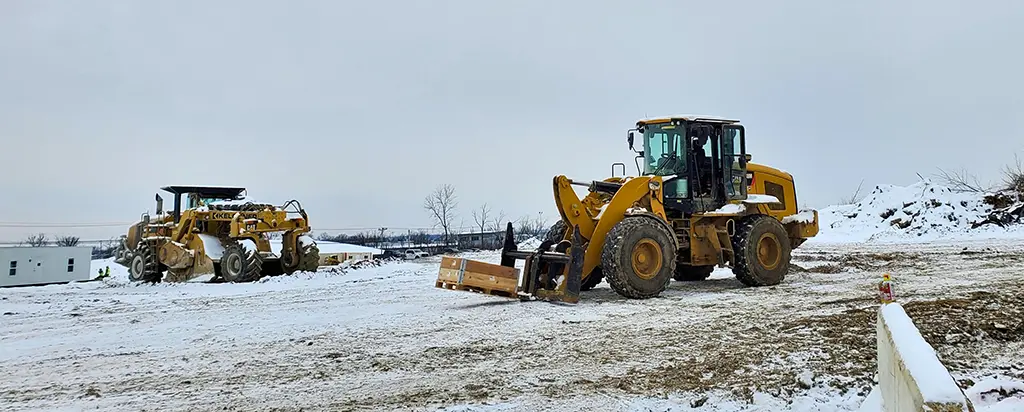Cold Weather Liming for Construction Sites: Everything That You Need to Know

Winter construction doesn’t have to mean costly shutdowns. Cold weather liming for construction sites leverages the exothermic reaction of lime-based products to dry, modify, and stabilize soils even in freezing conditions. This comprehensive guide covers the science behind lime’s heat-generating properties, best practices for winter application, temperature thresholds, and common mistakes to avoid.
Winter construction presents unique challenges that can derail project timelines and inflate budgets. When temperatures drop and frozen ground threatens work stoppage, many contractors face a difficult decision: winter shutdown until spring or find solutions that allow work to continue. Cold weather liming has become an essential technique for maintaining soil stability and workability throughout winter months. While Portland cement and other soil stabilization methods struggle in cold conditions, lime-based products offer a powerful advantage.
Get back to work with less downtime.
Understanding Cold Weather Challenges and the Role of Lime
Construction sites face numerous obstacles when temperatures drop. Frozen ground becomes nearly impossible to excavate or compact properly. Wet soils that might dry naturally in summer remain saturated for weeks. Equipment struggles to operate efficiently, and workers battle harsh conditions that slow productivity. These challenges compound when dealing with problematic soils that require treatment before construction can proceed. Whether you’re working on road stabilization projects or site stabilization for building pads, untreated problematic soils bring construction to a halt.
Traditional soil drying methods become ineffective in cold weather. Mechanical aeration relies on evaporation, which slows dramatically in cold, humid conditions. Simply waiting for better weather means costly delays, equipment sitting idle, and contractual deadlines slipping away. Remove-and-replace operations can become even more expensive as suitable replacement soils grow scarce, and hauling costs may rise during winter months
The Science Behind Lime as a Cold Weather Additive
Lime-based products work differently than other soil treatments because of their unique chemical properties. When quicklime (calcium oxide) or lime kiln dust encounters water in the soil, it triggers an immediate exothermic reaction. This reaction converts calcium oxide to calcium hydroxide, releasing substantial heat in the process. The temperature increase can be dramatic enough to create visible steam rising from treated soil, even on the coldest days.
This heat generation serves multiple purposes. First, it accelerates the drying process by converting excess moisture to vapor. Second, it keeps the soil mass warm enough for chemical reactions to continue despite cold ambient temperatures. Third, it enables the pozzolanic reactions that create long-term strength development in clay-bearing soils. These reactions form calcium-silicate-hydrates and calcium-aluminate-hydrates, the same compounds that give concrete its strength.
The beauty of lime stabilization lies in its efficiency. When quicklime (CaO) hydrates, it releases heat that accelerates drying and helps achieve optimal moisture content for compaction. Lime continues to improve soil through long-lasting chemical reactions, enhancing strength and stability well beyond the initial drying phase. This makes lime-based soil stabilization particularly effective as a cold weather soil stabilization method when other methods fail. For contractors managing winter construction projects, this heat-generating property becomes a game-changer.
What Are the Key Challenges of Using Lime Stabilization in Cold Weather?
Despite its advantages, cold weather does impact lime stabilization in several ways that contractors need to understand and plan for.
Slower Chemical Reactions
Understanding temperature thresholds helps contractors plan winter construction activities effectively. Below 40°F, lime reactions begin to slow. While the immediate drying and modification effects continue, the pozzolanic reactions that build long-term strength proceed at a reduced rate. Project specifications should account for this extended curing time when setting strength requirements and testing schedules.
Below 32°F, freezing conditions create additional concerns. Water expansion during freeze-thaw cycles can disrupt treated soil before stabilization is complete. However, proper lime treatment improves frost resistance once the initial stabilization reactions have progressed sufficiently, and the heat generated by lime hydration often keeps the soil mass above freezing even when air temperatures drop below this threshold.
Cold weather doesn’t stop lime from working. As long as machinery runs and safety standards are met, lime continues to deliver results. Mintek’s lime dried soil this past January when air temperatures were 7°F. Steam rose from the treated area, which became the warmest spot on site, allowing construction to continue without delay.
Less Work Time
Cold weather shortens daylight hours and creates challenging working conditions that reduce daily productivity. Limited sunlight not only compresses the workday but also affects ground conditions. When the sun is out, it helps warm the surface and soften frozen layers, creating a brief window of improved workability. However, these benefits are short-lived because winter days are much shorter, and low-angle sunlight provides less heat than in summer.
Equipment operators must work slower when visibility is reduced, so weather windows become critical. A crew might only have a few hours of optimal conditions between morning frost and evening freezes. This compressed schedule requires careful planning and coordination to maximize productivity during available work time. Reclaimers and spreader trucks play a critical role in maintaining efficiency on winter job sites, ensuring proper material distribution and thorough mixing even when dealing with stiff, cold soils.
What Best Practices Help Ensure Successful Stabilization in Winter Conditions?
Success with cold weather liming requires adapting standard construction practices to address winter conditions. These modifications can mean the difference between a successful project and costly delays:
Add water even to wet soils
Water is essential to activate the exothermic reaction. This may seem counterintuitive when you’re trying to dry saturated soil, but the distinction is important: total moisture content is different from available water for the reaction. That additional water kick-starts hydration, and the substantial heat generated will drive off far more moisture than you add, effectively drying the soil while maintaining elevated temperatures. Without it, lime can sit dormant in the soil, providing minimal benefit while cold conditions persist.
Increase lime dosage rates by 1-2%
Additional lime produces more heat through hydration and provides extra reactive material to offset slower reaction rates.
Seal the treated area immediately
Use a smooth drum roller to compact the surface, trapping heat like a blanket over the treated soil and maintaining elevated temperatures. In ideal weather conditions, hydration for quicklime and Calciment® LKD typically occurs within minutes to several hours. However, in cold temperatures below 40°F, a longer mellowing period may be needed to ensure complete hydration of the product and reaction with the soil.
Use high-powered mixing equipment
Use a soil reclaimer with aggressive mixing drums to ensure thorough lime distribution while generating additional heat through friction. Reclaimers are essential for proper incorporation – disc harrows and other old-fashioned scarifying equipment simply cannot achieve the mixing action needed for effective cold weather treatment. Spreader trucks allow precise metering of material, eliminating the high and low spots that occur when “blading” material around.
Schedule application during warmest hours
Schedule lime treatment during the warmest part of the day to maximize heat generation benefits. Coordinate with weather forecasts to avoid treating soils immediately before heavy precipitation or severe temperature drops.
Stage materials strategically
Keep lime products dry and protected from moisture until application to prevent premature reaction.
Enhancing Cement-Based Stabilization
When working with granular soils that are less conducive to lime, cold temperatures can significantly reduce Portland cement’s effectiveness. Adding just 1-2% quicklime with the cement can provide the heat needed for proper cement curing, even under winter conditions. This small addition of lime can generate enough exothermic reaction to maintain cement hydration that would otherwise stop below 40°F.
Adapting Construction Practices for Winter Liming
Beyond the technical adjustments to lime application, consider these operational changes:
- Plan for extended curing time in winter. What takes seven days in summer may require longer periods when working in winter months.
- Monitor soil temperature, not just air temperature. Specifications often reference air temperature thresholds, but we’re not working in the air – we’re working in the soil. Soil mass temperature matters more for reaction rates and strength development. A frozen crust might cover soil that’s still workable just inches below. If the soil mass stays warm, productive work can continue even when air temperatures plummet.
- Keep air/CO₂ off the treated surface to ensure reactivity.
- Consider the sequence of operations carefully. In winter construction, the order in which you tackle different areas of a site matters more than other seasons. Treat and stabilize critical access routes first to ensure equipment can continue moving throughout the site as work progresses.
- Think through any covering strategy. Placing soil over treated areas can help protect against freezing and moisture, but it must be planned carefully to avoid trapping water or weakening the stabilized layer.
Safety Guidelines for Cold Weather Liming
Winter conditions add complexity to lime handling safety protocols.
Proper Storage and Handling of Lime Materials in Winter
When transferring lime from storage to spreader trucks, minimize exposure time. Cold, wet conditions can cause lime to clump or begin reacting prematurely. Keep transfer equipment clean and dry to prevent buildup that could clog distribution systems.
Quality Control and Testing Procedures for Cold Weather Applications
Upfront testing is essential for winter construction. Cold weather slows reaction rates, so early lab testing provides the guidance needed to make informed decisions. Protect test samples from freezing during initial curing, as this can give false low readings that don’t represent field conditions where the soil mass retains heat.
Moisture content testing becomes critical in cold weather. The target moisture content for compaction might need adjustment to account for reduced evaporation rates. Use nuclear density gauges cautiously, as extreme cold can affect their calibration.
FAQs
Can lime be used with cement in cold weather?
Yes. Adding 1–2% quicklime to cement-treated soils helps maintain hydration and curing when temperatures fall below 40°F.
Can lime help thaw frozen soil?
Yes. In extreme cases, the heat from lime hydration has been used to thaw frozen ground and keep projects moving.
Can lime be stored outside in winter?
Lime should be kept dry and covered. Moisture from snow or condensation can trigger premature reactions and reduce effectiveness.
About Mintek Resources
Since 1994, Mintek Resources has provided proven lime-based solutions for construction sites across the United States. With a distribution network spanning 29+ states and over 20 DOT approvals, we bring unmatched technical expertise to every cold weather construction challenge. Our products, including Calciment® LKD, quicklime, and Construction Quicklime (CQL), are specifically designed to perform when conditions get tough.
Our Innovation Center’s soil lab helps determine the right product and application rate for your specific soil conditions, taking the guesswork out of winter construction. Whether you’re stabilizing roadways, preparing building pads, or treating problematic soils, our technical team provides the support needed to keep your project moving forward, regardless of the weather.
When winter conditions threaten your construction schedule, trust Mintek’s decades of experience in cold weather soil treatment. We’re here to help you find the best solution for your next project. Let’s get started. Give me a call at 937-641-9901.
We're here to help you find the best solution for your next project. Let's get started. Give me a call at 937-641-9901.

Josh Weser
Mintek Resources
Related Posts
Tariffs Disrupt Construction: Lime Keeps Projects Moving
Tariffs are reshaping the construction landscape. From cement and steel to aluminum and other essential materials, shifting trade policies are creating ripple effects across the industry. Even when prices hold steady, the uncertainty around future costs and sourcing...
Unlocking Pavement Potential: The Long-Term Value of Chemically Stabilized Subgrades
A Foundation in Crisis America’s roadways are the backbone of its economy and daily life, yet they continue to show signs of chronic underinvestment. According to the American Society of Civil Engineers’ 2025 Infrastructure Report Card, the nation’s infrastructure...
Ground Control: Comparing Lime and Geosynthetics for Long-Lasting Stability
When building infrastructure on weak in-situ soils, a well-designed foundation is essential to ensure long-term resilience. Whether you're constructing roads, embankments, or industrial platforms, ensuring subgrade stability is critical—not just for performance, but...